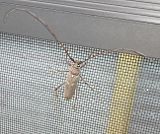This is an old revision of this page, as edited by BilledMammal (talk | contribs) at 02:17, 31 October 2022 (→Timbaraba: Include content from Timbaraba). The present address (URL) is a permanent link to this revision, which may differ significantly from the current revision.
Revision as of 02:17, 31 October 2022 by BilledMammal (talk | contribs) (→Timbaraba: Include content from Timbaraba)(diff) ← Previous revision | Latest revision (diff) | Newer revision → (diff) Tribe of beetles
| Bothriospilini | |
|---|---|

| |
| Bothriospila elegans | |
| Scientific classification | |
| Domain: | Eukaryota |
| Kingdom: | Animalia |
| Phylum: | Arthropoda |
| Class: | Insecta |
| Order: | Coleoptera |
| Suborder: | Polyphaga |
| Infraorder: | Cucujiformia |
| Family: | Cerambycidae |
| Subfamily: | Cerambycinae |
| Tribe: | Bothriospilini |
Bothriospilini is a tribe of beetles in the subfamily Cerambycinae.
In 2005, Monné and Napp transferred the genera Ranqueles and Scapanopygus to the tribe based on cladistic analysis.
Bothriospila
Main article: BothriospilaThe only species in the genus Bothriospila is Bothriospila elegans. It was described by Aurivillius in 1923.
Chlorida
Main article: ChloridaThe genus Chlorida contains the following species:
| Image | Species | First described | Range | Synonyms |
|---|---|---|---|---|
 |
Chlorida cincta | Guérin-Méneville, 1844 | Mexico, Colombia, Ecuador | |
| Chlorida costata | Audinet-Serville, 1834 | Brazil, Paraguay, Argentina, Uruguay | ||
| Chlorida curta | Thomson, 1857 | French Guiana, northern central Brazil, Ecuador |
| |
 |
Chlorida denticulata | Buquet, 1860 | Guianas | |
| Chlorida fasciata | Bates, 1870 | North western Brazil, Ecuador | ||
 |
Chlorida festiva | (Linnaeus, 1758) | South eastern United States, Central America, South America, West Indies |
|
| Chlorida inexpectata | Martins, Galileo & Oliveira, 2011 | Brazil | ||
| Chlorida obliqua | Buquet, 1852 | Colombia | ||
| Chlorida spinosa | Aurivillius, 1887 | Colombia, Bolivia, Ecuador | ||
| Chlorida transversalis | Buquet in Guérin-Méneville, 1844 | Colombia |
Chrotoma

The only species in the genus Chrotoma is Chrotoma dunniana. It was described by Casey in 1891.
Delemodacrys
Main article: DelemodacrysThe only species in the genus Delemodacrys is Delemodacrys mourei. It was described by Martins & Napp in 1979.
Gnaphalodes
Main article: GnaphalodesThe only species in the genus Gnaphalodes is Gnaphalodes trachyderoides. It was described by Thomson in 1860.
Knulliana

The only species in the genus Knulliana is Knulliana cincta, commonly known as the banded hickory borer. It was described by Drury in 1773. It is about 15–30 mm in length and occurs throughout the eastern half of North America, including Mexico and the Bahamas. If roughly handled it may start to squeak furiously. They are usually found on hickory trees and oak trees, where they lay their eggs; the larvae bore into the trees, sometimes doing significant damage.
It has three described subspecies:
- Knulliana c. cincta (Drury) - Eastern North America, Texas
- Knulliana cincta ochracea (Bates) - Southeastern United States, Northeastern Mexico, Bahamas
- Knulliana cincta sonorensis (Schaeffer) - Texas to Arizona, adjacent regions in Mexico
Ranqueles
Main article: Ranqueles (beetle)The genus Ranqueles was circumscribed by French entomologist Pierre-Émile Gounelle in 1906, with the South American R. mus assigned as the type, and at that time, only species. It now contains the following species:
| Species | First described | Range |
|---|---|---|
| Ranqueles gounellei | Bosq, 1947 | Northern central Argentina |
| Ranqueles mus | Gounelle, 1906 | North western Argentina |
| Ranqueles steparius | Di Iorio, 1996 | Neuquén Province in Argentina |
Scapanopygus
Main article: ScapanopygusThe only species in the genus Scapanopygus is Scapanopygus cinereus. Both the genus and species were described in 1913 by French entomologist Pierre-Émile Gounelle. The type specimen was collected from Averías, a municipality in Argentina, on the banks of the Salado River.
Taygayba
Main article: TaygaybaThe only species in the genus Taygayba is Taygayba venezuelensis. It was described by Martins and Galileo in 1998. It is found in Venezuela.
Timbaraba
Main article: TimbarabaThe only species in the genus Timbaraba is Timbaraba dispar. It was described by Monne and Napp in 2004. It occurs in Venezuala and has filiform (threadlike) antennae with 11 segments, and a trapezoidal mentum.
References
- ^ Bezark, Larry G. A Photographic Catalog of the Cerambycidae of the World Archived 2013-08-27 at the Wayback Machine. Retrieved on 22 May 2012.
- Monné, Marcela Laura; Napp, Dilma Solange (2005). "Cladistic analysis of the tribe Torneutini Thomson (Coleoptera: Cerambycidae: Cerambycinae: Trachyderoinia)". Zootaxa. 1062 (1): 1–56. doi:10.11646/zootaxa.1062.1.1.
- "Chrotoma Genus Information". BugGuide.net. Retrieved 2018-03-04.
- "Chrotoma Report". Integrated Taxonomic Information System. Retrieved 2018-03-04.
- "Chrotoma Overview". Encyclopedia of Life. Retrieved 2018-03-04.
- "Browse Chrotoma". Catalogue of Life. Retrieved 2018-03-04.
- Monné, Miguel A. & Hovore, Frank T. (2005) Electronic Checklist of the Cerambycidae of the Western Hemisphere. PDF
- Gounelle, P.E. (1906). "Chasses de M. Carlos Bruch dans l'Argentine. Description d'un nouveau genre et d'une nouvelle espèce de cérambycides". Bulletin de la Société Entomologique de France (in French). 1906: 140–142.
- Bezark, Larry G. A Photographic Catalog of the Cerambycidae of the World. Retrieved on 22 May 2012.
- Gounelle, P.E. (1913). "Chasses de M. E.-R. Wagner, correspondant du Muséum, dans les provinces du Nord de la République Argentine. Cérambycides nouveaux ou peu connus". Bulletin du Muséum national d'histoire naturelle (in French). 19 (4): 193–231.
- Martins, U.R.; Galileo, M.H.M. (1998). "Nova sinonímia e novos táxons em Cerambycidae (Coleoptera) neotropicais". Revista Brasileira de Zoologia. 15 (1): 47–58. doi:10.1590/S0101-81751998000100002.
- Monné, M.L.; Napp, D.S. (2005). "New South American Genus and Species, and Notes on Xenambyx lansbergei (Thomson) (Coleoptera: Cerambycidae: Cerambycinae: Torneutini)". The Coleopterists Bulletin. 58 (4): 509–512. JSTOR 4009833.
| Taxon identifiers | |
|---|---|
| Bothriospilini |
|
This Cerambycinae article is a stub. You can help Misplaced Pages by expanding it. |